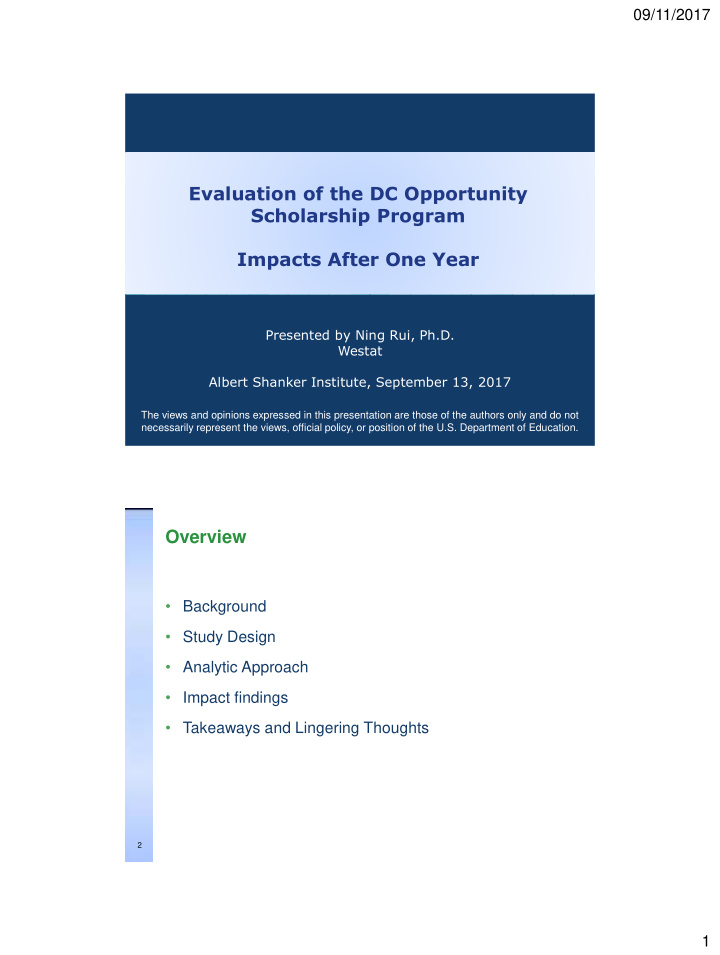



09/11/2017 Evaluation of the DC Opportunity Scholarship Program Impacts After One Year Presented by Ning Rui, Ph.D. Westat Albert Shanker Institute, September 13, 2017 The views and opinions expressed in this presentation are those of the authors only and do not necessarily represent the views, official policy, or position of the U.S. Department of Education. Overview • Background • Study Design • Analytic Approach • Impact findings • Takeaways and Lingering Thoughts 2 1
09/11/2017 Background 3 Key Features of OSP Under SOAR Act • Scholarships (adjusted annually for inflation) – Up to $8,000 (K – 8) – Up to $12,000 (9 – 12) • Student eligibility criteria – Resident of DC, entering grades K – 12 – Household income at or below 185% of the Federal poverty line • Priority groups – Siblings in program (+40%) – Attending school in need of improvement or previous awardee and never used scholarship (+25%) 4 2
09/11/2017 OSP, Authorization and Evaluation • Annual authorization – $20M for OSP – Also $20M for DCPS and charter schools • Evaluation – Independent – Use strongest possible research design – Focus on specified outcomes – Broadly disseminate findings 5 Previous Evaluation Findings A previous study of the OSP program from 2004-2009 found that the program had: No significant effects on reading and mathematics test scores after 4 years A positive impact on high school graduation, as reported by parents. A positive impact on satisfaction and perceptions of school safety for parents, but not for students. 6 3
09/11/2017 Study Design 7 Randomized Control Trial (RCT) • Student applicants are assigned by lottery to either receive scholarship offer (treatment) or not (control) • RCT design is considered “gold standard” for research: Aspects not measured or measurable (such as aspirations, motivation, and attitudes toward education) same for both groups • Outcome differences between students offered and not offered scholarships are impacts of the offer 8 4
09/11/2017 Number of Eligible Applicants and Lottery Assignment • Lotteries for evaluation held in 2012, 2013, 2014 – 1,771 students applied – 995 scholarships offered (56%) • 70 percent of students used their scholarship in the first year it was offered to them • Scholarship use in first year was similar to other voucher programs with lotteries – First OSP: 77 percent – New York City: 75 percent – Louisiana: 77 percent for first-choice school, 68 percent overall 9 Baseline Characteristics • Treatment and control groups were similar at time of application on key student and parent characteristics – Test scores in reading, mathematics – Gender – Race – Attending SINI school at time of application – Parent college attendance – Parent employment 10 5
09/11/2017 Key Outcomes • Reading and mathematics test scores ( TerraNova ) • Satisfaction: Parent or student gives school a grade of A or B • Perceptions of school safety: Parent or student rates school as very safe • Parent involvement in school events • Parent involvement in education in the home 11 Analytic Approach 12 6
09/11/2017 Approach for Estimating Impacts • ‘Intent to treat’ impacts— regression models with baseline covariates • Impacts of scholarship use — impact divided by scholarship use rate (Bloom adjustment) • Impacts for subgroups — interact treatment indicator and subgroup indicator • Weights were used to correct for differential probabilities of selection – Small number of control-group parents were subsampled and weighted 13 Impact Findings 14 7
09/11/2017 No statistically significant impact on reading achievement and negative impact on mathematics achievement *Difference between the treatment group and the control group is statistically significant at the 0.05 level. 15 No significant impact on parent or student satisfaction Percent giving school a grade of A or B 16 8
09/11/2017 Positive impact on parent perceptions of school safety and no significant impact on student perceptions Percent rating school as very safe *Difference between the treatment group and the control group is statistically significant at the 0.05 level. 17 No significant impact on parent involvement in education at school or at home 18 9
09/11/2017 Takeaways and Lingering Thoughts • The OSP had a negative impact on mathematics achievement after one year. • The OSP did not have an impact on parents’ or students’ general satisfaction with the school the child attended in the first year. • The program had a positive impact on parents’ perceptions of safety at the school their child attended in the first year. • The OSP did not have an impact on parent involvement in education overall. • These results are snapshot views of the OSP impacts in the early stage; future evaluation reports will address impacts after two and three years 19 Questions & Comments Ning Rui, Westat NingRui@westat.com 20 10
Recommend
More recommend